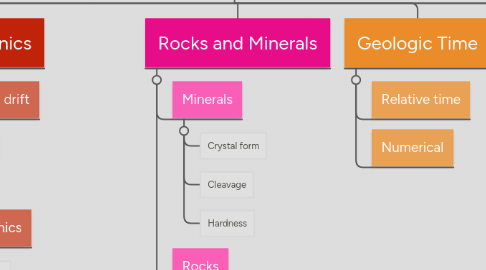
1. Universe and Solar System
1.1. Hypothesis
1.1.1. Geocentric
1.1.2. Heliocentric
1.2. Size of the Universe
1.2.1. Luminosity
1.2.2. Doppler Effect
1.3. Big Bang Theory
1.3.1. Big explosion
1.3.2. compact to not rapidly
1.4. Stars and Planets
1.4.1. Gravity pulls together dust clouds
1.4.2. Nuclear fussion
1.5. Our Solar System
1.5.1. The Sun
1.5.1.1. 99.8% of total mass of Solar System
1.5.1.2. solar wind
1.5.1.3. Sunspot cycle
1.5.2. A Planet
1.5.2.1. Rotates around a sun/star
1.5.2.2. Radius of at least 400km
1.5.2.3. Spherical
1.5.2.4. Cleared its neighbors
1.5.3. Seasons
1.5.3.1. Earth and sun
1.5.3.2. Winter solstice
1.5.3.3. Spring Equinox
1.5.3.4. Summer solstice
1.5.3.5. Autumn equinox
1.5.4. The Earth
1.5.4.1. Crust
1.5.4.2. Mantle
1.5.4.3. Core
1.5.4.4. Geothermal Gradient
2. Rocks and Minerals
2.1. Minerals
2.1.1. Crystal form
2.1.2. Cleavage
2.1.3. Hardness
2.2. Rocks
2.2.1. Sedimentary
2.2.1.1. Clastic
2.2.1.2. Chemical
2.2.1.3. Biochemical
2.2.2. Metamorphic
2.2.2.1. Contact
2.2.2.2. Regional
2.2.3. Igneous
2.2.3.1. Volcanic
2.2.3.2. Plutonic
3. Weathering and Soil
3.1. Funding
3.1.1. Employee
3.1.2. Employee
3.2. Tax filings
3.2.1. Employee
3.2.2. Employee
3.3. Payroll
3.3.1. Employee
3.3.2. Employee
4. Plate Tectonics
4.1. Continental drift
4.1.1. Wegener
4.1.2. Pangea
4.2. Plate Tectonics
4.2.1. Convection
4.2.2. Seafloor
4.2.3. Lithosphere
4.2.4. Earthquake
4.2.5. Continental plates
4.3. Plate tectonic bounderies
4.3.1. Divergent
4.3.2. Convergent
4.3.3. Transform
4.4. Fault movement
4.4.1. Waves
4.4.1.1. P waves
4.4.1.2. S waves
4.4.1.3. Surface waves
4.4.1.3.1. Reighleigh
4.4.1.3.2. Love
4.4.2. Parts
4.4.2.1. Focus
4.4.2.2. Epicenter
4.4.2.3. Fault scarp
4.4.3. Types of Faults
4.4.3.1. Normal
4.4.3.2. Reverse
4.4.3.3. Strike-slip
4.4.4. Earthquake size
4.4.4.1. Intensity
4.4.4.1.1. Mercalli scale
4.4.4.2. Magnitude
4.4.4.2.1. Richter
4.5. Volcanoes and other mountains
4.5.1. Sheild
4.5.2. Strato
4.5.3. Cinder cone
4.5.4. Caldera
4.5.5. Lava Plateau
5. Geologic Time
5.1. Relative time
5.2. Numerical
6. Atmosphere
6.1. Layers
6.1.1. Troposphere
6.1.2. Stratosphere
6.1.3. Mesosphere
6.1.4. Thermosphere
6.2. Protect earth from
6.2.1. Solar and Cosmic Radiation
6.2.2. Debris
6.3. Contains Weather Systems
6.3.1. Wind
6.3.2. Clouds and Precipitation
6.3.3. Fronts and Air masses
